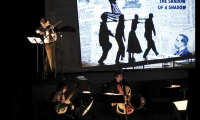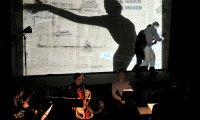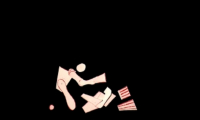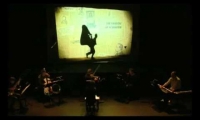Video
Telegrams from the Nose
François Sarhan, William Kentridge
and Daniil Harms
Telegrams from the Nose
Kurt Schwitters Sonate in Urlauten (1932)
for voice solo
with a cadenza by Georges Aperghis
Charlie Chaplin The Hynkel Speech (1940)
for voice, transcribed by Michael Schmid after The Great Dictator
Video William Kentridge
Music François Sarhan
Poems Daniil Harms
Igor Semenoff: stroh-violin
François Deppe: stroh-cello, voice
Tom Pauwels: acoustic guitar
Jean-Luc Plouvier: keyboard
François Sarhan: speaker
Alexandre Fostier: sound
Georges-Elie Octors: conductor
Production Ictus
Coproduction Opéra de Lille, La Rose des Vents (Villeneuve d'Ascq)
Using the original music of François Sarhan (with the composer himself in pantomime) and texts of Daniil Harms, the South-African artist William Kentridge proposes a 45 minute medium-format, between musical theatre, animated video images and installation. Evocation of the stalinian 20s in Russia: futurism and constructivism mix in with the minutes of the trial of Fiodor Bukharin. Disappearance, threat, and oppression are masked by the grotesque, the speed, the vitality: terror installs itself, but in a wave of frenzy and unbridled artistic imagination. On a canvas painted in the manner of an old magazine boasting the advances of science, Kentridge projects a turbulent theatre of human shadows that run towards the victory of the new man. Sarhan's music, modern sky at will, precipitates the race. But the representation gets out of control: at any moment, censure interrupts.
About the music
In phase with Kentridge's images, the music of "Telegrams" scrolls through a series of hurried, scratched out, dislocated "Shostakovian vignettes". It is a work of memory and allusion, without any direct quotations. As always with Sarhan, it is the text (the spoken voice) that carries him away: here the composer pursues his quest for a modern melodrama. An a-lyrical narration, like a voice sample imported direct from everyday life (or an archive or old film), is used as the guiding thread, attaching a rich harvest of instrumental events to itself like glue.
Rusland anno 1920: het futurisme en het constructivisme gedijen goed in de Sovjetunie: verlichte kunstenaars en intellectuelen verwachten veel van de artistieke en sociale revolutie. De verwarring is totaal als de genadeloze processen onder Stalin van start gaan en een hele generatie kunstenaars buiten spel gezet wordt. De tekst in deze muziektheatervoorstelling is een letterlijke weergave van de laatste minuten in het proces tegen 'Fiodor Bukharin' doorweven met fragmenten uit het werk van Daniil Harms, een ander slachtoffer van de Stalin terreur. Isolement, ironie, bedreiging en onderdrukking worden verhuld door het groteske, de snelheid en de dynamiek. De animatiefilm van Kentridge en de muziek van Sarhan verhouden zich nu eens als begeleiding in een stomme film, dan weer als figuranten in een melodrama of als pantomime in relatie tot een geanimeerde tekenfilm.
Entre théâtre musical, vidéo, installation, ce moyen-format destiné à de petites salles est le fruit de la collaboration entre l'artiste sud-africain William Kentridge et le compositeur français François Sarhan, lui-même présent sur le plateau en speaker et pantomime. Futurisme russe, poèmes de Daniil Harms et minutes des procès staliniens s'y entremêlent. Le matériel graphique provient des études préliminaires à la mise en scène du "Nez" de Chostakovitch, que préparait Kentridge pour le Metropolitan Opera en 2010.
Sarhan et Kentrdige évoquent les années ’20 et ’30 en Russie, en osant une spectaculaire collision : le procès de Nikolaï Bukharin, qui est mis en accusation par Staline, est narré selon les codes artistiques du modernisme radical des mêmes années. Disparition, menace et oppression sont masquées par le grotesque, la vitesse, la vitalité : la terreur s’installe, mais dans une vague de frénésie et d’imagination artistique débridée. . Sur une toile peinte à la manière d’un vieux magazine vantant les avancées de la science, Kentridge projette un turbulent théâtre d’ombres humaines, qui courent vers la victoire de l’homme nouveau. La vidéo met en mouvement une association raffinée d'ombres humaines anamorphosées, d'animation de petites silhouettes noires en papier découpé, de formes géométriques évoquant le constructivisme russe, de lettres, de texte. La musique de Sarhan, modernsky à souhait - une série de vignettes "à la russe" empressées, raturées, disloquées – en précipite la course. Mais la représentation dérape : à tout moment, la censure l’interrompt.
À ces Telegrams grotesques grépondent la Sonate in UrLauten de Kurt Schwitters, premier grand poème phonétique, et le célèbre discours du chancelier Adenoïd Hynkel — alias Chaplin — dans Le Dictateur.
Agenda for this project
- Date Show Location
-
Fri 07.02 Telegrams from the Nose La Rose des Vents - Villeneuve d'Ascq - France

Sarhan | Kentridge: Telegrams from the nose
Constructivist cartoons, stroh-music and Daniil Harms poems read more



